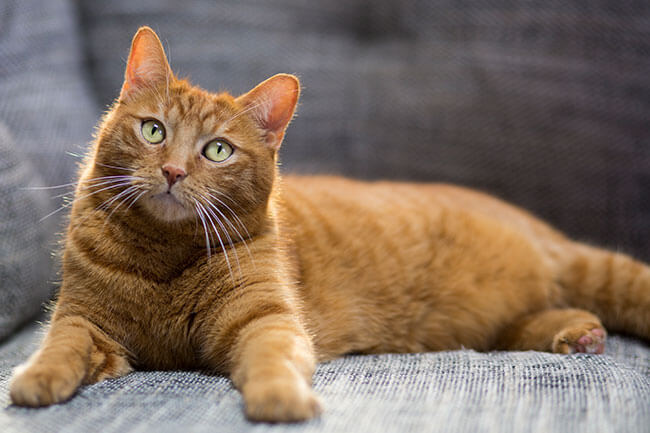Why Is My Cat Losing Weight But Still Eating?

Unexpected weight loss in your feline friend can be concerning. Like weight gain, weight loss is a serious issue in cats. When your cat is losing weight but still eating, there might be an underlying medical problem, particularly hyperthyroidism or diabetes.
If your cat is losing weight rapidly or is underweight, consult your veterinarian.
What are Signs of Hyperthyroidism?
A common sign of hyperthyroidism in cats is losing weight on a healthy diet. Hyperthyroidism often results from a benign tumor on the thyroid gland that elevates thyroid hormones. Essentially, it skyrockets your cat’s metabolism.
On top of weight loss, hyperthyroidism may cause increased drinking and urination, vomiting, diarrhea, muscle wasting, and increased activity. Cats with hyperthyroidism may beg for food and attention. Cats with hyperthyroidism also may start to urinate outside the litterbox. While hyperthyroidism is more common in senior cats, it can be diagnosed in cats as young as six.
Sadly, the symptoms can also get more severe. Cats with hyperthyroidism may have high blood pressure. They may also develop heart disease, leading to its own host of complications such as blindness, heart failure, and stroke.
Because of their increased metabolism, cats can’t eat enough food to keep their weight on. It’s imperative that if your cat shows signs of hyperthyroidism, that you take your furry friend to the vet immediately. Merely increasing the amount of food your cat eats won’t be enough.
Treatments for Hyperthyroidism
There are typically three main treatment paths for hyperthyroidism.
Medication
Medication is almost always the first option. In most cases, you’ll want to try out medication before anything more invasive. Medication, such as methimazole, is supposed to help suppress the thyroid hormone.
The medicine can’t cure hyperthyroidism; it just manages it. Your furry friend will have to take it for the rest of his life.
Surgery
If medication doesn’t work and your cat doesn’t have underlying liver disease, your cat may be eligible for surgery. The surgery involves carefully extracting the tumor from the thyroid gland, but it’s often risky.
Radiotherapy
The goal of radiotherapy is to eliminate the tumor without invasive surgery. It’s considered the safest and most effective of thyroid treatments. It has a 97-98% success rate!
No matter what, it’s crucial to take your cat to the vet if she’s displaying hyperthyroidism symptoms.
What are Signs of Feline Diabetes?
Unfortunately, not only does diabetes affect humans, but our feline friends. Diabetes occurs when the system can’t appropriately respond to the hormone insulin. This means that the levels of sugar glucose in the blood are elevated. Sugar glucose is the body’s primary source of energy. The risk factors for diabetes include obesity, increasing age, physical inactivity, and being male.
One of the main warning signs of feline diabetes is weight loss despite a healthy diet. Other warning signs include increased thirst and urination. No matter the type of diabetes, the blood cells become starved for energy, resulting in weight loss and an increased appetite.
Your vet can diagnose diabetes with a blood glucose reading.
Treatment for Diabetes
Diabetes is most often treated through a combination of insulin and dietary therapy. The goals in diabetes treatments are to restore blood glucose concentrations, stop or control weight loss, minimize increased thirst and urination, and avoid low blood sugar due to the treatment (hypoglycemia).
Insulin Therapy
Like in humans, injectable insulin is a primary treatment for feline diabetes. If your cat gets diagnosed with diabetes, make sure to discuss each type of insulin’s pros and cons with your veterinarian.
Insulin injections are typically given every twelve hours. While it seems intimidating, vets will teach owners how to give injections properly. Cat owners usually find it relatively easy due to the small needle.
Dietary Therapy
A low-carb diet has been shown to improve blood sugar regulation in cats. There are many prescription foods available in wet and dry forms.
Throughout the entire treatment, it’s essential to monitor your cat closely. While taking care of a cat with diabetes seems intimidating, it’ll significantly increase your cat’s quality of life when you do it properly.
Signs Your Cat has Intestinal Parasites
Intestinal parasites are prevalent in cats. There are many types of parasites, from wormlike parasites to single-celled organisms. Parasites can wreak havoc on your cat’s system.
They often cause vomiting and diarrhea, contributing to weight loss even if your cat is still eating. They can also make it harder for your cat to properly get nutrients from his food, meaning that he has to eat more.
Treatment for Parasites
Thankfully, treatment is pretty straightforward. Most parasites just require a quick trip to the vet and some medication. Most parasite re-infections are common, but they’re preventable.
Make sure you’re taking proper sanitation measures to the litter box and the spaces your cat spends time in. Avoid feeding your cat raw meats.
When to Go to the Vet
Even if your cat’s weight loss doesn’t seem severe, there are some serious conditions associated with weight loss. There’s also a host of other issues that could potentially be a cause for your cat’s sudden weight loss. Potential Problems with the liver, GI tract, and heart can also lead to unexplained weight loss.
It’s far better to be safe than sorry when it comes to caring for your cat. In order to make sure she’s as comfortable as possible during this time, a trip to the vet is the best way to go. It’s never a fun process taking your cat to the vet.
Even getting them in the carrier can be stressful, but the care your vet can provide can vastly improve your cat’s quality of life and get ahead of any issues before they get too serious.
